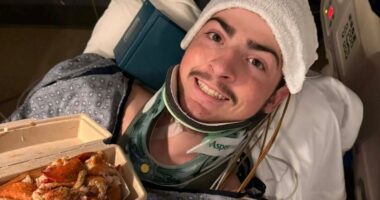A tourist died after falling from a train as she hung her head out of the carriage while trying to take a photo in Sri Lanka.
Olga Perminova, 53, was traveling on the iconic Podi Menike rail line when she made the decision to lean out of an open door for a dangerous photo opportunity.
Reports from the local area indicate that the woman collided with a rock, resulting in severe head injuries, as she was gripping two rails and leaning her head out of the carriage.
The Russian traveller, who was seen in her last photo wearing a pink dress, died later in hospital.
Perminova was a passenger on the Podi Menike train, known for its breathtaking views that include verdant tea plantations, dense forests, mountainous regions, and charming landscapes.
But she tragically ‘died after falling off the train when attempting to take a selfie while hanging from the train footboard between the Badulla and Hali Ela railway stations,’ said a local report citing police.
‘The woman knocked against a rock, fell off the train and sustained severe injuries.’
The train was heading for Ella, home to the famous Nine Arches Bridge on a line that has been called one of the world’s greatest rail experiences.

Olga Perminova, 53, was travelling on the legendary Podi Menike rail line when she decided to lean out of an open door in a deadly picture opportunity

The Russian traveller, who was part of a Russian travel group, died later in hospital

She suffered severe head injuries after hitting a rock when she leaned out of the carriage
The traveller, who was part of a Russian tour group in Sri Lanka, was given emergency treatment but died from her head injuries.
Perminova, a grandmother, worked for a security company in Moscow region, and was originally from Saratov.
Russian diplomats are now handling the arrangements for repatriating her body following the selfie tragedy.
It comes after a tourist plunged to his death in a Colombian beauty spot while trying to take a selfie.
Tobias Fischer, 35, died during his solo hike in the mountains in the Taganga district, northern Colombia, on October 19 near where he was staying in the port city of Santa Maria.
He tried to take a selfie at a viewpoint in the Dumbira forest with the sea in the background when he lost his balance and fell down a ravine.
Last year, research suggested that taking selfies should be considered a ‘public health problem’.
Academics in Australia analysed scientific papers and media reports on injuries or deaths from selfies worldwide since 2008.
They found nearly 400 had been reported over the 13 years considered in the study.

Perminova was on the Podi Menike train, famed for its spectacular scenery as it passes lush tea plantations

Perminova, a grandmother, worked for a security company in Moscow region, and was originally from Saratov
Victims were most likely to be female tourists in their early 20s, while falling and drowning while taking a photo the leading two causes of death.
Researchers said the public must be made aware of the risks posed by selfies – with an estimated 92million snapped globally every day – and urged social media apps to install software to warn people of the dangers as they go to take a selfie.
Dr Samuel Cornell, a risk expert at the University of New South Wales, Australia, and others wrote in the paper: ‘The selfie-related incident phenomenon should be viewed as a public health problem that requires a public health response.
‘To date, little attention has been paid to averting selfie-related incidents through behavior change methodologies or direct messaging to users through apps.
‘Although previous research has recommended “no selfie zones”, barriers and signage as ways to prevent selfie incidents, our results suggest this may not be enough.
‘It may be prudent to also engage in direct safety messaging to social media users.’

















